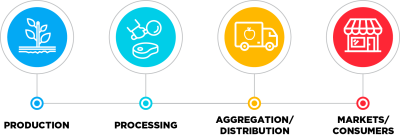The U.S. Department of Agriculture (USDA) recently announced its "Build Back Better" initiative that will invest more than $4 billion to strengthen the U.S. food system, including investments in “distribution and aggregation.”
The USDA notes that the system’s infrastructure has been stressed during the Covid-19 pandemic because of “long shipping distances and lack of investment in local and regional capacity.” USDA plans to invest in distribution-and-aggregation infrastructure that can “remain resilient, flexible, and responsive.”
Further supporting infrastructure solutions to supply chain issues, the secretaries of Agriculture, Transportation, and Commerce will co-chair a new Supply Chain Disruptions task force to bring a “whole of government” response to near-term supply-chain challenges to the economic recovery.
The new effort will strengthen the food system, create new market opportunities, tackle the climate crisis, help communities that have been left behind, and support good-paying jobs throughout the supply chain, the USDA said. The announcement by the USDA supports the Biden administration’s broader work on strengthening the resilience of critical supply chains as directed by Executive Order 14017 America's Supply Chains. Funding is provided by the American Rescue Plan Act and earlier pandemic assistance such as the Consolidated Appropriations Act of 2021.

Through the Build Back Better initiative, USDA will help to ensure the food system of the future is fair, competitive, distributed, and resilient; supports health with access to healthy, affordable food; ensures growers and workers receive a greater share of the food dollar; and advances equity as well as climate resilience and mitigation. While the Build Back Better initiative addresses near- and long-term issues, recent events have exposed the immediate need for action, the USDA said. With attention to competition and investments in additional small- and medium-sized meat processing capacity, the Build Back Better initiative will spur economic opportunity while increasing resilience and certainty for producers and consumers alike.
“The Covid-19 pandemic led to massive disruption for growers and food workers. It exposed a food system that was rigid, consolidated, and fragile. Meanwhile, those growing, processing and preparing our food are earning less each year in a system that rewards size over all else,” said Agriculture Secretary Tom Vilsack. “The Build Back Better initiative will make meaningful investments to build a food system that is more resilient against shocks, delivers greater value to growers and workers, and offers consumers an affordable selection of healthy food produced and sourced locally and regionally by farmers and processors from diverse backgrounds. I am confident USDA’s investments will spur billions more in leveraged funding from the private sector and others as this initiative gains traction across the country. I look forward to getting to work as co-chair of the new Supply Chain Disruptions Task Force and help to mobilize a whole-of-government effort to address the short-term supply challenges our country faces as it recovers.”
The Build Back Better Initiative will strengthen and transform critical parts of the U.S. food system, the USDA said. As it makes investments through this initiative, USDA will also seek to increase transparency and competition with attention to how certain types of conduct in the livestock markets and the meat processing sector have resulted in thinly-traded markets and unfair treatment of some farmers, ranchers and small processors. Among other investments in the food system and food supply chain, Build Back Better will specifically address the shortage of small meat processing facilities across the U.S. as well as the necessary local and regional food system infrastructure needed to support them, the USDA said.
Funding announcements under the Build Back Better initiative will include a mix of grants, loans, and innovative financing mechanisms for the following priorities, each of which includes mechanisms to tackle the climate crisis and help communities that have been left behind, including:
- Food Production: Food production relies on growers, including farmers and ranchers, workers, and critical inputs. But a diminishing share of the food dollar goes to these essential workers. USDA will invest in the current and future generation of food producers and workers throughout the food system with direct assistance, grants, training and technical assistance, and more.
- Food Processing: The pandemic highlighted challenges with consolidated processing capacity. It created supply bottlenecks, which led to a drop in effective plant and slaughter capacity. Small and midsize farmers often struggled to compete for processing access. USDA will make investments to support new and expanded regional processing capacity.
- Food Distribution & Aggregation: Food aggregation and distribution relies on people working together throughout the food system and having the right infrastructure to gather, move and hold the food where and when it is needed. This system was stressed during the pandemic due to long shipping distances and lack of investment in local and regional capacity. USDA will make investments in food system infrastructure that can remain resilient, flexible and responsive.
- Markets & Consumers: The U.S. spends more on health care and less on food than any other high-income nation, yet the U.S. has higher rates of diet-related illness and a lower life expectancy than those nations. At the same time, many socially disadvantaged and small and mid-sized producers do not have equitable access to markets. USDA will support new and expanded access to markets for a diversity of growers while helping eaters access healthy foods.
USDA will continue to make announcements through the Build Back Better initiative in the future. This announcement is in addition to the $1 billion announced recently to purchase healthy food for food insecure Americans and build food bank capacity, putting the total announced thus far at more than $5 billion.





